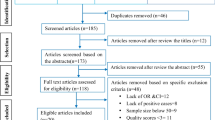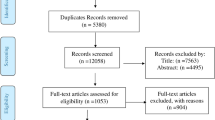Abstract
Purpose
The prevalence of obesity is an escalating concern in modern populations, predominantly attributed to the widespread adoption of sedentary lifestyles observed globally. Extensive research has established a significant association between obesity and Helicobacter pylori (H. pylori). Nonetheless, a comprehensive assessment of the global prevalence of H. pylori among individuals with obesity remains undetermined.
Methods
A systematic search strategy was applied to PubMed, Scopus, and Web of Science. The resulting records were screened using the Rayyan online tool for the management of systematic reviews. Freeman–Tukey double arcsine transformation was used. Subgroup analyses (continent, regional classifications, developmental status, religion, global hemisphere, income, access to international waters, and H. pylori eradication) and multivariate meta-regression (latitude, longitude, male-to-all ratio, mean age, and body mass index) were done to estimate the effects of the moderators. Risk of bias assessment was done using JBI checklist for prevalence studies.
Results
A total of 472,511 individuals with obesity from 208 studies were included. The global estimation of H. pylori prevalence among individuals with obesity was 32.3% (95% CI 26.9%, 38.0%). South America had the highest prevalence. Based on the different classifications of countries, resource-rich, low-/middle-income, developing, and Islamic countries had the highest prevalence. Lower pooled prevalence was observed in the studies with adequate sample sizes (n ≥ 270).
Conclusion
The findings have the potential to influence future health policies for preventing and treating H. pylori infection. However, there is variability among the included studies, indicating the need for more population-based research.





Similar content being viewed by others
Data availability
The data underlying this article are available in the article and in its online supplementary material.
Abbreviations
- H. pylori :
-
Helicobacter pylori
- GI:
-
Gastrointestinal
- JBI:
-
Joanna Briggs institute
- BMI:
-
Body mass index
- COVID-19:
-
Coronavirus disease of 2019
- RoB:
-
Risk of bias
References
Lin X, Li H. Obesity: epidemiology, pathophysiology, and therapeutics (in eng). Front Endocrinol. 2021;12:706978. https://doi.org/10.3389/fendo.2021.706978.
Camilleri M, Malhi H, Acosta A. Gastrointestinal complications of obesity (in eng). Gastroenterology. 2017;152(7):1656–70. https://doi.org/10.1053/j.gastro.2016.12.052.
Li Y, Choi H, Leung K, Jiang F, Graham DY, Leung WK. Global prevalence of Helicobacter pylori infection between 1980 and 2022: a systematic review and meta-analysis. Lancet Gastroenterol Hepatol. 2023;8(6):553–64. https://doi.org/10.1016/S2468-1253(23)00070-5.
Zamani M, et al. Systematic review with meta-analysis: the worldwide prevalence of Helicobacter pylori infection (in eng). Aliment Pharmacol Ther. 2018;47(7):868–76. https://doi.org/10.1111/apt.14561.
Hooi JKY, et al. Global prevalence of Helicobacter pylori infection: systematic review and meta-analysis (in eng). Gastroenterology. 2017;153(2):420–9. https://doi.org/10.1053/j.gastro.2017.04.022.
Baradaran A, et al. The association between Helicobacter pylori and obesity: a systematic review and meta-analysis of case-control studies (in eng). Clin Diabetes Endocrinol. 2021;7:15. https://doi.org/10.1186/s40842-021-00131-w.
Chen Y, Blaser MJ. Association between gastric helicobacter pylori colonization and glycated hemoglobin levels. J Infect Dis. 2012;205(8):1195–202. https://doi.org/10.1093/infdis/jis106.
Liu J, et al. The synergy of Helicobacter pyloriand lipid metabolic disorders in induction of Th17-related cytokines in human gastric cancer. J Cancer Metast Treat. 2017;3:169–76.
Page MJ, et al. The PRISMA 2020 statement: an updated guideline for reporting systematic reviews (in eng). BMJ. 2021;372:n71. https://doi.org/10.1136/bmj.n71.
E. Aromataris and Z. Munn, JBI Manual for Evidence Synthesis: JBI, 2020. https://synthesismanual.jbi.global.
Borges Migliavaca C, et al. How are systematic reviews of prevalence conducted? A methodological study. BMC Med Res Methodol. 2020;20:96. https://doi.org/10.1186/s12874-020-00975-3.
Sadeghi A, Dehdari Ebrahimi N. Global prevalence of Helicobacter pylori infection among individuals with obesity: A protocol for a systematic review and meta-analysis. Health Sci Rep. 2023;6:e1505. https://doi.org/10.1002/hsr2.1505.
Ouzzani M, Hammady H, Fedorowicz Z, Elmagarmid A. Rayyan-a web and mobile app for systematic reviews. Syst Rev. 2016;5:210. https://doi.org/10.1186/s13643-016-0384-4.
World Health Organization. Obesity: preventing and managing the global epidemic: report of a WHO consultation. Geneva: World Health Organization; 2000.
Pieper D, Puljak L. Language restrictions in systematic reviews should not be imposed in the search strategy but in the eligibility criteria if necessary (in eng). J Clin Epidemiol. 2021;132:146–7. https://doi.org/10.1016/j.jclinepi.2020.12.027.
Scherer RW, Saldanha IJ. How should systematic reviewers handle conference abstracts? A view from the trenches. Syst Rev. 2019;8:264. https://doi.org/10.1186/s13643-019-1188-0.
Munn Z, Moola S, Lisy K, Riitano D, Tufanaru C. Methodological guidance for systematic reviews of observational epidemiological studies reporting prevalence and cumulative incidence data (in eng). Int J Evid Based Healthc. 2015;13(3):147–53. https://doi.org/10.1097/xeb.0000000000000054.
Munn Z, Moola S, Riitano D, Lisy K. The development of a critical appraisal tool for use in systematic reviews addressing questions of prevalence (in eng). Int J Health Policy Manag. 2014;3(3):123–8. https://doi.org/10.15171/ijhpm.2014.71.
Freeman MF, Tukey JW. Transformations related to the angular and the square root. Ann Math Stat. 1950;21:607–11. https://doi.org/10.1214/aoms/1177729756.
Doi SA, Xu C. The Freeman-Tukey double arcsine transformation for the meta-analysis of proportions: recent criticisms were seriously misleading (in eng). J Evid Based Med. 2021;14:259–61. https://doi.org/10.1111/jebm.12445.
Higgins JP, Thompson SG. Quantifying heterogeneity in a meta-analysis (in eng). Stat Med. 2002;21(11):1539–58. https://doi.org/10.1002/sim.1186.
Lender N, et al. Review article: associations between Helicobacter pylori and obesity - an ecological study. Aliment Pharmacol Ther. 2014;40(1):24–31. https://doi.org/10.1111/apt.12790.
Naing L, Winn T, Nordin R. Pratical issues in calculating the sample size for prevalence studies. Arch Orofac Sci. 2006;1:9–14.
Hunter JP, Saratzis A, Sutton AJ, Boucher RH, Sayers RD, Bown MJ. In meta-analyses of proportion studies, funnel plots were found to be an inaccurate method of assessing publication bias (in eng). J Clin Epidemiol. 2014;67(8):897–903. https://doi.org/10.1016/j.jclinepi.2014.03.003.
Cochrane Handbook for Systematic Reviews of Interventions, 2nd ed, Wiley, Chichester, 2019.
Lees N. The Brandt line after forty years: The more North-South relations change, the more they stay the same? Rev Int Stud. 2021;47(1):85–106. https://doi.org/10.1017/S026021052000039X.
Themrise K, Seye A, Catherine K, Madhukar P. How we classify countries and people—and why it matters. BMJ Glob Health. 2022;7: e009704. https://doi.org/10.1136/bmjgh-2022-009704.
Nocaj A, Brandes U. Computing voronoi treemaps: faster, simpler, and resolution-independent. Comput Graph Forum. 2012;31:855–64. https://doi.org/10.1111/j.1467-8659.2012.03078.x.
Sasaki H, et al. Hypergastrinemia in obese noninsulin-dependent diabetes: a possible reflection of high prevalence of vagal dysfunction (in eng). J Clin Endocrinol Metab. 1983;56:744–50. https://doi.org/10.1210/jcem-56-4-744.
Sachs G, Scott D, Weeks D, Melchers K. Gastric habitation by Helicobacter pylori: insights into acid adaptation. Trends Pharmacol Sci. 2000;21:413–6.
Meyer-Rosberg K, Scott DR, Rex D, Melchers K, Sachs G. The effect of environmental pH on the proton motive force of Helicobacter pylori (in eng). Gastroenterology. 1996;111:886–900. https://doi.org/10.1016/s0016-5085(96)70056-2.
Wisén O, Rössner S, Johansson C. Gastric secretion in massive obesity. Evidence for abnormal response to vagal stimulation (in eng). Dig Dis Sci. 1987;32:968–72. https://doi.org/10.1007/bf01297185.
Mushref MA, Srinivasan S. Effect of high fat-diet and obesity on gastrointestinal motility (in eng). Ann Transl Med. 2013;1:14. https://doi.org/10.3978/j.issn.2305-5839.2012.11.01.
Testerman TL, Mobley HLT. Adherence and colonization. In: Mobley HLT, Hazell SL, editors. Helicobacter pylori physiology and genetics. Washington (DC): ASM Press; 2001.
Versalovic J. Manual of clinical microbiology. American Society Mic Series; 2011
Lu C, Yu Y, Li L, Yu C, Xu P. Systematic review of the relationship of Helicobacter pylori infection with geographical latitude, average annual temperature and average daily sunshine. BMC Gastroenterol. 2018;18:50. https://doi.org/10.1186/s12876-018-0779-x.
Yang L, He X, Li L, Lu C. Effect of vitamin D on Helicobacter pylori infection and eradication: a meta-analysis (in eng). Helicobacter. 2019;24: e12655. https://doi.org/10.1111/hel.12655.
Aziz RK, Khalifa MM, Sharaf RR. Contaminated water as a source of Helicobacter pylori infection: a review (in eng). J Adv Res. 2015;6:539–47. https://doi.org/10.1016/j.jare.2013.07.007.
Kayali S, et al. Helicobacter pylori, transmission routes and recurrence of infection: state of the art (in eng). Acta Bio-med Atenei Parmensis. 2018;89:72–6. https://doi.org/10.23750/abm.v89i8-S.7947.
Higgins JPT. Commentary: heterogeneity in meta-analysis should be expected and appropriately quantified. Int J Epidemiol. 2008;37:1158–60. https://doi.org/10.1093/ije/dyn204.
Migliavaca CB, et al. Meta-analysis of prevalence: I(2) statistic and how to deal with heterogeneity (in eng). Res Synth Methods. 2022;13:363–7. https://doi.org/10.1002/jrsm.1547.
Barker TH, et al. Conducting proportional meta-analysis in different types of systematic reviews: a guide for synthesisers of evidence. BMC Med Res Methodol. 2021;21:189. https://doi.org/10.1186/s12874-021-01381-z.
Funding
None.
Author information
Authors and Affiliations
Contributions
AS conceptualized, supervised, performed the search and analysis, and visualized the results. AS and NDE screened the records for eligibility. NDE and FN extracted the data. MAS and ET assessed the quality of the studies. AS and ET provided the draft. NDE revised the manuscript. All authors read and approved the final version of the manuscript.
Corresponding authors
Ethics declarations
Conflict of interest
The authors declare that the present study was done in the absence of any financial and personal competing interests.
Supplementary Information
Below is the link to the electronic supplementary material.
Rights and permissions
Springer Nature or its licensor (e.g. a society or other partner) holds exclusive rights to this article under a publishing agreement with the author(s) or other rightsholder(s); author self-archiving of the accepted manuscript version of this article is solely governed by the terms of such publishing agreement and applicable law.
About this article
Cite this article
Sadeghi, A., Nouri, F., Taherifard, E. et al. Estimates of global and regional prevalence of Helicobacter pylori infection among individuals with obesity: a systematic review and meta-analysis. Infection (2024). https://doi.org/10.1007/s15010-024-02244-7
Received:
Accepted:
Published:
DOI: https://doi.org/10.1007/s15010-024-02244-7




